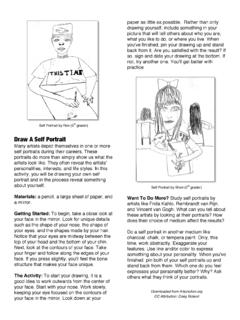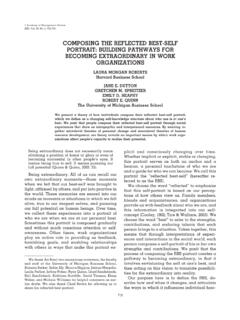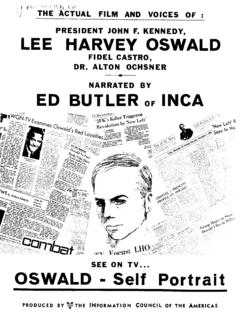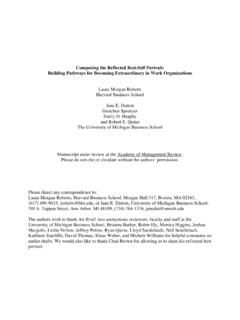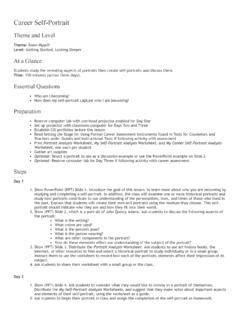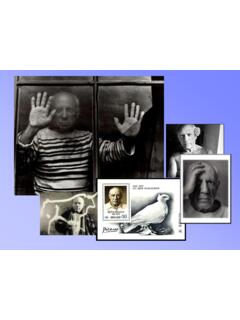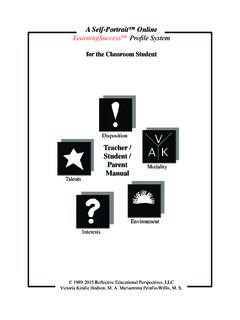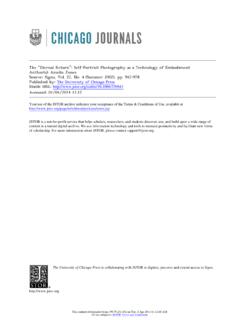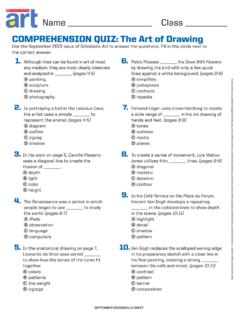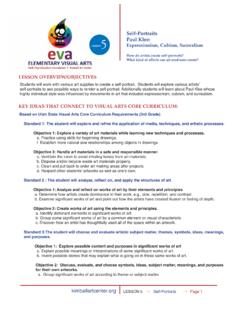Transcription of Archibald J. Motley Jr., ARCHIBALD MOTLEY
1 LESSON PLAN byTHE ART OF ARCHIBALDMOTLEYCONNECT,COLLABORATE& CREATE:Todd Osborne, NBCT, Kenwood Academy,Chicago Public SchoolsArchibald J. MOTLEY Jr., self portrait (Myself at Work), 1933. Oil on canvas, x inches ( x cm). Collection of Mara MOTLEY , MD, and Valerie Gerrard Browne. Image courtesy of the Chicago History Museum, Illinois. Valerie Gerrard Browne. How can I use symbolism to represent aspects of my life and interests? What emotion(s) do I want to convey with my self - portrait ? How can I do this? How do the environment, dress, and facial expressions of a self - portrait convey meaning? How can I apply The Elements and Principles of Art to convey an idea or emotion?
2 (If you are unfamiliar with the Elements and Principles of Art, you can access descriptions here: ). Students will know who ARCHIBALD MOTLEY Jr. was and his place in art history. Students will know techniques to create the art element of space in an artwork. Students will understand the significance of MOTLEY s work and the Harlem and Chicago Renaissance. Students will understand the use of symbolism works of art. Students will learn strategies for expressing ideas using visual imagery. Students will understand how to use tools in Adobe Photoshop to select, adjust and edit images from a variety of sources including: a camera, scanner and the internet.
3 Students will create a personal artwork, inspired by MOTLEY s painting, that depicts themselves at work doing something they are passionate about. Like MOTLEY , they will incorporate symbolism into their expression to represent their interests. Images carry symbolic meaning and can be used to express ideas through visual (non-textual) communication. Images are intentionally constructed to convey meaning and evoke some form of reaction in their audience. Creation (of an artwork, musical score, written story, science experiment, etc.) is a self -critical process, requiring experimentation, exploration and this unit for grades 9-12 students will view, discuss and critique artworks by ARCHIBALD MOTLEY Jr.
4 And other artists of the Harlem and Chicago Renaissance. After critical analysis of artworks, they will create a personal artwork inspired by MOTLEY s painting self - portrait (Myself at Work), 1933. Students will create a digital artwork in Photoshop repre-senting themselves at work doing something they are passionate about, including symbolic visual representations in their backgrounds. Though designed to teach a specific software application, themes of this plan can be adapted to multiple art of lesson planBig IdeaEnduring QuestionsLearning ObjectivesStandardCommon Core State StandardsObjective-Students will .. NAEA Anchor Standard #1: Creating multiple interpretations of a story, drama, or poem ( , recorded or live production of a play or recorded novel or poetry)
5 , evaluating how each version inter-prets the source text Students will generate and con-ceptualize artistic ideas and Anchor Standard #6 Preforming /Presenting a case in which grasping a point of view requires distinguish-ing what is directly stated in a text from what is really meant Students will convey meaning through the presentation of artistic Anchor Standard #7 RespondingStudent will perceive and analyze artistic Anchor Standard #10 ConnectingStudents will synthesize and relate knowledge and personal experiences to make Plan ActivitiesLength: This is a 7-10 day art project divided in 50-minute class period lessons Materials: Art critique worksheet Computer lab with internet writing software and Adobe Photoshop, Digital projector Digital cameras (camera phones), Scanner (optional) and printer (preferred, but optional)Day 1: Introduction and written art critique (see attached work-sheet) of MOTLEY s self - portrait (Myself at Work).
6 Day 2: Overview of MOTLEY s artwork and his place in art history, through a slide presentation and class discussion of his work. Establish purpose: share quotes about work. Slide presentation and discussion of MOTLEY s artwork; focus on self - portrait (Myself at Work), 1933. Demonstrate techniques for creating the illusion of space in an artwork. Introduction of Photoshop art-making skills and student art project: A portrait of Myself (& Symbols) at Work Teacher will demonstrate creating the illusion of space in an artwork. Teacher will demonstrate new Photoshop skills (selecting and remov-ing backgrounds, adjusting color and value, editing size to arrange images and com-pose artwork) with overhead projector.
7 Students will follow along while applying these new skills. Days 3-5: Student studio art-making practice: ideations, image gathering, and using cameras to take portraits Students will select a theme for their artwork, depicting themselves at work doing something they are passion-ate about. Themes may in-clude sports, art-making, writ-ing, performing, conducting a science experiment, solving an equation on a whiteboard, etc. Students will work with a partner to take an expressive portrait . They will also collect symbolic images with cameras, scan-ners and from the internet to represent at least 7 aspects of their life, hopes for the future or personal interests.
8 Student begin to compile images and begin editing their images in Photoshop. Teacher provides feedback, and guided 6-9: Student studio art-making practice: using Adobe Photo-shop to select, adjust and edit images. Students will use Photo-shop to create a self - portrait collage; they will arrange and edit their various images to create a meaningful artwork of themselves at work. They will apply techniques to create the illusion of space in an artwork. Students arrange the ele-ments of their artworks, and apply the techniques of cre-ating space in an artwork to create their compositions. Teacher provides guided practice, one-on-one critiques, supportive feedback, 10: self assessment rubric and written reflection on creative process (see attached rubric)Assessments: (D) DiagnosticGeneral class survey: What was the Harlem Renaissance?
9 Who was ARCHIBALD MOTLEY ? Can any-one explain or provide information about either of these? What is sym-bolism? What is self -portraiture? How does one create the illusion of space in an artwork?(F) Formative the check for understanding mechanisms used throughout the unit to ensure each student gets the instruction needed to be successful on the summative performance assessment. Examples: reader s notebooks, post-it jots, small group an-ecdotal records, discussion, critiques by teacher and peers. Individual critical questioning by teacher regarding student s intention and expres-sive techniques. Small-group discussions.(S) Summative the summary of student s achievement in relation standards.
10 ARCHIBALD MOTLEY attended the School of the Art Institute of Chicago where he learned the principles of portraiture. He ex-celled at visualizing his sitter s interior personalities through the use of exterior signs such as costume, pose, and setting as well as color, light, and line. In 1929, he won a Guggenheim Fellowship that allowed him to study in Paris, where he further honed his skills. Briefly MOTLEY painted murals and taught painting classes at Howard University. Later, he worked as a paint-er for the Easel and Mural Division of the WPA. He also taught painting and composition lessons at his home studio. MOTLEY s focus on portraits and inclusion of himself at work, reflects his determination to see African American subjects in fine art.
